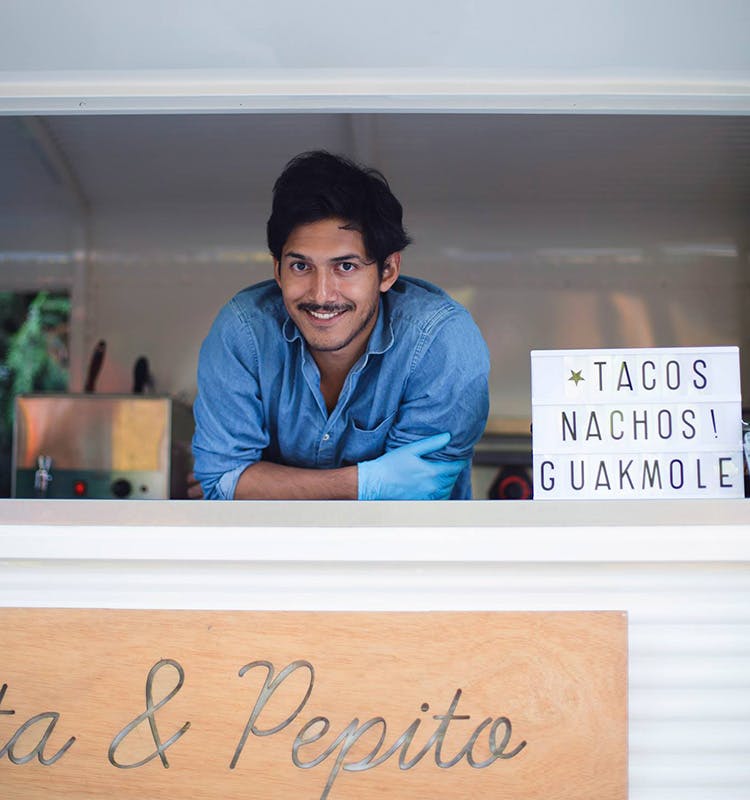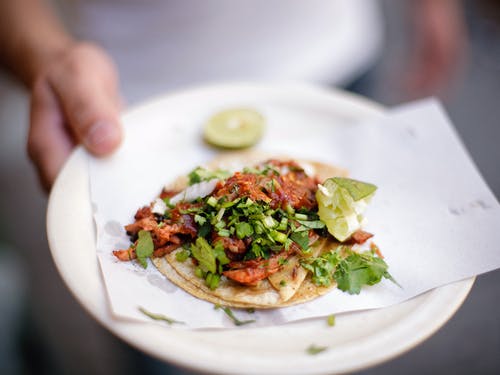Ask any resident of Mexico City, and they'll tell you that the best taco in town is the taco de ojo—literally "cow eye taco"—sold at a taqueria on the corner of Benito Juárez and Las Fuentes. Or maybe it's the campechano, made with spicy chopped chorizo and beef, found at the vendor underneath a highway overpass somewhere on Avenida Río Churubusco. Or perhaps it's the barbacoa—lamb or mutton wrapped in banana leaves and cooked in the ground for hours and sold by the kilo at a hole-in-the-wall on Pablo Veronés.
Like pizza for New York City, where the particulars of crust, sauce and cheese are so fiercely debated that pizza wars are an actual thing, Mexico City residents debate the specifics of tortillas, fillings and salsas in an effort to find their city's best taco. A few spots regularly pop up on best-of lists, like the al pastor tacos at daytime auto-shop-turned-late-night taqueria El Vilsito and the one-of-a-kind beef and bacon tacos at Tacos Manolo, but chat up a local about their favorite, and you'll find it is often rooted in deep personal preference and heritage.
. . . chat up a local about their favorite, and you'll find it is often rooted in deep personal preference and heritage.
"Tacos have a lot to do with memories," Ismael Ordaz says. Born in Oaxaca and raised in Mexico City, Ordaz carried his love of Mexico City's street tacos to Lupita & Pepito, his food truck that was based in Barcelona, Spain. "What taquerias are trying to do is give you what they think is the best flavor possible, but how they go about that varies from stand to stand." The "best" taco is not necessarily the one with the highest-quality ingredients or atmosphere, but that one particular taco from that one particular cart that tastes like home. As a result, Mexico City is home to an infinite number of taco variations, with each bite offering a glimpse into someone's memory.

Perhaps the tacos de guisado, one of the most popular variants for the everyday CDMX native, smell like the guisado that wafted down the street on the walk home from school. Found across the city in restaurants, street markets and just on the side of the road, humble guisados are essentially home-style stews served in tortillas. While they evoke that unmistakable feeling of a hearty, home-cooked meal (or comida casera), they aren't flashy. The fillings are usually prepared off-site before being brought to markets and displayed in disposable tins or ceramic bowls. More of a concept than a singular dish, guisados come in hundreds of varieties that vary from cook to cook, from chicharrón en salsa verde (pork rinds in a green tomatillo sauce) to lengua en salsa de morita (beef tongue in a morita pepper sauce) to tinga de pollo (chicken stewed in tomatoes and onions).
And then there are tacos árabes, the lesser-known precursor to the famously delicious tacos al pastor. Tacos árabes appeared in the early 20th century when Lebanese immigrants (or maybe Iraqi . . . no one is really sure) brought the concept of the kebab to the Mexican state of Puebla. Pueblan cooks adapted the vertical rotisseries, called trompos, to Mexican tastes by subbing out lamb for pork. Eventually, tortillas replaced pitas and a spicy, salty, sweet adobo sauce emerged, paving the way for what we now know as tacos al pastor. These days, bright-orange al pastor trompos dot the sidewalks of Mexico City like streetlights against a night sky, while tacos árabes are harder to find. But a well-done taco arabe, like the one found at Taqueria El Greco, transports you back to when the two cultures collided.
Though al pastor may be the ubiquitous taco in Mexico City, the range and scope of flavor of stuffed tortillas extends well beyond the trompos. Sizzling choriceras, large metal pans with shallow middles and deep sides, are home to bubbling suadero—skirt, flank or brisket—that simmers in fat for hours until it's chopped on a large wooden block and delivered on a warm tortilla. The suadero absorbs the flavor of all the meat being cooked on the choricera—from tripe to longaniza, a sausage similar to chorizo—which means each taqueria's offerings taste a little different depending on what's bubbling on the choricera that day.
Photo: Cyrus McCrimmon/Getty Images
"You can only get good at tacos by eating a lot of tacos," Ordaz says. "As we say in Mexico, 'Como gordita en tobogán,' which means, 'Let yourself go like a fat lady on a slide' and eat as much as you can. That's when you start to appreciate how this taco has more fat and this taco has better ingredients and this sauce is really complimentary."
It takes experience and strategy not only to discern good tacos from the great, but to recognize which taco stands are friendly to foreigners' stomachs. When choosing a taco stand, first look at the price: The difference of a few pesos may not seem like a big deal to tourists, but the price of a single taco can tell you a lot about the quality of a stand. Look for tacos that average eight to 15 pesos each. There will be outliers, like 35-peso shrimp tacos and six-peso tacos de canasta (or "basket tacos" that are stacked in a basket, covered in hot oil and left to steam until a hungry patron comes along). "But if you see something like five tacos for 10 pesos, it's a no go," Ordaz notes. "The meat could be compromised."
Next, give the taco stand a whiff. If the oil or lard in the choricera smells pungent and overpowers the smell of the meat, the oil is old and it's not a good taco. "You have to actually be able to smell the longaniza and the mix of meat. If the oil smell is really, really strong, it's a no go," Ordaz advises.
Photo: Todd Coleman
Then, look at the salsas. Though fillings get all the attention, it's the salsa that perks up your taste buds and balances the taco on your palate. Good taquerias will have a few salsa options, usually a red chile sauce and a much spicier green sauce, along with other offerings that can range from lightly pickled onions and habaneros to spicy guacamole to nopales (cactus). Ordaz says to look for salsas that are bright and fresh, and avoid taquerias with soupy offerings. "If the salsas are watery, then they don't care about their taco."
And, of course, look for the people and stay away from empty stands with dry al pastor trompos or prepared fillings that indicate a low turnover. "The people know," Ordaz adds. "The place where you see the most people is where they do things well, because everyone eats on the street. Without that, Mexico City wouldn't be so exciting. You can find something really delicious on every corner, and everyone has their favorite taco."
Brooke Siem is a writer and professional chef currently meandering around the world. Follow her on Instagram at @brookesiem.




